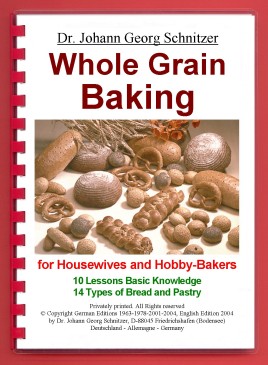Didn't you always
wish to bake your own healthy and tasty bread?
An old Chinese proverb says: "Only God knows, how
the next war will end, and what's inside the bread". From now on,
at least the latter you will be able to know - if baking your own
healthy and tasty bread. From the viability (germinability) of the
cereal grains up to the fresh, healthy and tasty bread and pastry on
your table, everything will be under your own control.
Nowadays, people are increasingly worried about the countless impurities,
chemicals and processing aids they consume with their food. Many suffer
from allergies, and therefore try to eliminate the unknown causes from
their food, by practicing a more natural nutrition.
E.g. in Germany, there are more than 1000 processing aids
(“improvers”) for baking, which legally don’t need to be declared
(Heike u. Peter Vertens in „mehr wissen, besser leben“, 2/2004,
Stuttgart). These processing aids serve to improve the technical
processing of dough: E.g. to reduce the stickiness; to increase their
water binding capacity; to produce beautifully looking bakery products
despite only mediocre quality of the flour (e.g. growth impaired flour
from sprouted grain because of a rainy harvest time); to lengthen the
freshness and shelf life of the products (e.g. by mold inhibitors); to
reach an elastic crumb; to increase the volume yield; to improve the
freezing stability of dough (e.g. to avoid the release of water when
thawing the frozen dough pieces). None of these processing aids take aim
at improving the health value of bread and pastry products.
Already in 1992, 230,000 ton of processing aid substances, pre-fabricated
baking mixes, flavorings and filling paste were produced in Germany
alone (source: Informationen des Backmittelinstituts, April 2004 on the
Internet <http://www.backmittelinstitut.de>).
This Institute of baking processing aids was founded in 1983 by the
Association of the German producers of processing aids and baking mixes,
having over 40 companies as members.
Consequently, if you really want to know “What’s inside your
bread”, the best way is to bake it yourself – that’s too a great
fun for you, and for the children even a “learning by doing” baking
feast. How to produce whole grain bread and pastry of optimal health
value, taste and appearance, is described in this book. If you observe
the recipes precisely, you can rely on them, because so many times
proven practically in my seminars “Whole Grain Baking” and by so
many families.
My great thanks to David B. McCollum for having
controlled my English in the book!
Friedrichshafen, Lake of Constance, Germany, 2004
Dr. Johann
Georg Schnitzer
|
| In 1963, Dr. Johann Georg
Schnitzer started an information campaign about healthy nutrition in the Black
Forest village Moenchweiler, cooperating with the major and the municipal
council, to prevent tooth decay in the young generation, which already started
in babies of 18 months age at that time. (Immediately he was persecuted by
lobbies living upon tooth decay, who tried to to stop the campaign!). Whole
grain breads and pastry should replace the common products made from refined
extra short flour. But such products weren't available, except the traditional
heavy North-German whole meal breads, which couldn't hit the taste of the
South-German population.
Therefore, Dr. Schnitzer went to the bakers of the village
and asked them, to grind cereal grains on an old crushing mill as fine as
possible, and with such freshly milled whole grain flour to produce light
whole grain breads and pastry. "That's impossible", was the bakers'
response. From such flour, they said, nothing regular could be produced.
However, Dr. Schnitzer didn't give up; he started his own
experiments, after having taken a one day training in a bakery from 3 a.m. to
2 p.m., to acquire the basic baking knowledge. As first results, he could
develop a tasty wheat-rye whole grain bread, and simple whole grain rolls.
|
Two bakeries of the village
started to produce them, and the healthy bakery products were accepted and
consumed by the population.
The fresh whole grain breads and rolls met with increasing
approval, even outside the village. Many people traveled twice per week up to
100 km, to provide themselves with these tasty bakery products. A growing
interest of customers and bakers developed, to learn baking such healthy
breads and pastry.
Again Dr. Schnitzer started experiments, this time with
professional equipment. On his request, WINKLER provided him with a
professional baking oven, ERKA with a classic high speed mixer with lift. The
experiments were difficult and took about 6 months: The right dough
composition, kneading time, resting phase, proofing, final proof, rework,
baking time, initial temperature, final temperature for the different types of
bread and pastry had to be determined.
"Now or never!", one day Dr. Schnitzer said to
himself, and continued experimenting during the whole night. This meant the
long-due breakthrough to him. The conditions were worked out, which allow to
produce whole grain breads and pastry of optimal properties, concerning
health, taste and appearance.
|

